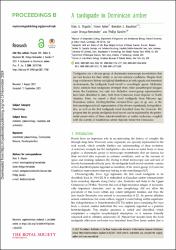| License | Creative Commons Attribution License, which permits unrestricted use, provided the original author and source are credited. | es |
| Author | Mapalo, Marc A. | |
| Author | Robin, Ninon | |
| Author | Boudinot, Brendon E. | |
| Author | Ortega-Hernández, Javier | |
| Author | Barden, Phillip | |
| Accessioned date | 2024-11-19T23:37:08Z | |
| Available date | 2024-11-19T23:37:08Z | |
| Year | 2021 | |
| Citation | Mapalo, M. A., Robin, N., Boudinot, B. E., Ortega-Hernández, J., & Barden, P. (2021). A tardigrade in Dominican amber. Proceedings of the Royal Society B, 288(1960), 20211760. Recuperado de: | es |
| URI | https://bvearmb.do/handle/123456789/5440 | |
| Abstract | Tardigrades are a diverse group of charismatic microscopic invertebrates that are best known for their ability to survive extreme conditions. Despite their long evolutionary history and global distribution in both aquatic and terrestrial environments, the tardigrade fossil record is exceedingly sparse. Molecular clocks estimate that tardigrades diverged from other panarthropod lineages before the Cambrian, but only two definitive crown-group representatives have been described to date, both from Cretaceous fossil deposits in North America. Here, we report a third fossil tardigrade from Miocene age Dominican amber. | es |
| Language | English | es |
| Published | Proceedings of the Royal Society B, 288(1960), 20211760 | es |
| Rights | © 2021 The Authors. Published by the Royal Society. | es |
| Rights URI | https://creativecommons.org/licenses/by/4.0/ | es |
| Subject | Biodiversidad - República Dominicana | es |
| Subject | Fauna ─ República Dominicana | es |
| Subject | Hábitats y especies | es |
| Subject | Paleobiología | es |
| Title | A tardigrade in Dominican amber | es |
| dc.identifier.doi | https://doi.org/10.1098/rspb.2021.1760 | |
| Material type | Article | es |
| Type of content | Scientific research | es |
| Access | Open | es |
| Audience | Technicians, professionals and scientists | es |


